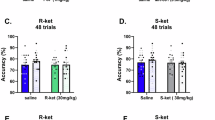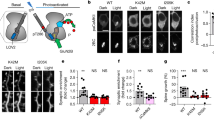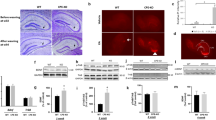Abstract
Aim:
To investigate the effect and underlying mechanisms of polygalasaponin F (PGSF), a triterpenoid saponin isolated from Polygala japonica, on long-term potentiation (LTP) in hippocampus dentate gyrus (DG) of anesthetized rats.
Methods:
Population spike (PS) of hippocampal DG was recorded in anesthetized male Wistar rats. PGSF, the NMDAR inhibitor MK801 and the CaMKII inhibitor KN93 were intracerebroventricularly administered. Western blotting analysis was used to examine the phosphorylation expressions of NMDA receptor subunit 2B (NR2B), Ca2+/calmodulin-dependent kinase II (CaMKII), extracellular signal-regulated kinase (ERK), and cAMP response element-binding protein (CREB).
Results:
Intracerebroventricular administration of PGSF (1 and 10 μmol/L) produced long-lasting increase of PS amplitude in hippocampal DG in a dose-dependent manner. Pre-injection of MK801 (100 μmol/L) or KN93 (100 μmol/L) completely blocked PGSF-induced LTP. Furthermore, the phosphorylation of NR2B, CaMKII, ERK, and CREB in hippocampus was significantly increased 5–60 min after LTP induction. The up-regulation of p-CaMKII expression could be completely abolished by pre-injection of MK801. The up-regulation of p-ERK and p-CREB expressions could be partially blocked by pre-injection of KN93.
Conclusion:
PGSF could induce LTP in hippocampal DG in anesthetized rats via NMDAR activation mediated by CaMKII, ERK and CREB signaling pathway.
Similar content being viewed by others
Log in or create a free account to read this content
Gain free access to this article, as well as selected content from this journal and more on nature.com
or
References
Chung IW, Moore NA, Oh WK, O'Neill MF, Ahn JS, Park JB, et al. Behavioural pharmacology of polygalasaponins indicates potential antipsychotic efficacy. Pharmacol Biochem Behav 2002; 71: 191–5.
Peng W, Xu S . Antitussive and expectorant effects of four saponins isolated from Polygala tenuifolia wild. Chin Pharm J 1998; 3: 491.
Zhang D, Miyase T, Kuroyanagi M, Umehara K, Ueno A . Studies on the constituents of Polygala japonica Houtt I. Structures of polygalasaponins I–X. Chem Pharm Bull 1995; 43: 115–20.
Wei-dong ZHANG, Ting-zhao LI, Chuan ZHANG, inventors; Zheng Dan Corporation, assignee. Polygalasaponin compounds and aglycones, total saponins and total aglycones and their application in medicine. China patent CN1651453A. 2005 Aug 10.
Xue W, Hu JF, Yuan YH, Sun JD, Li BY, Zhang DM, et al. Polygalasaponin XXXII from Polygala tenuifolia root improves hippocampal-dependent learning and memory. Acta Pharmacol Sin 2009, 30: 1211–9.
Citri A, Malenka RC . Synaptic plasticity: multiple forms, functions, and mechanisms. Neuropsychopharmacology 2008, 33: 18–41.
Morris RG . Elements of a neurobiological theory of hippocampal function: the role of synaptic plasticity, synaptic tagging and schemas. Eur J Neurosci 2006, 23: 2829–46.
Kesner RP, Hopkins RO . Mnemonic functions of the hippocampus: a comparison between animals and humans. Biol Psychol 2006; 73: 3–18.
Kesner RP . A behavioral analysis of dentate gyrus function. Prog Brain Res 2007; 163: 567–76.
Trommer BL, Kennelly JJ, Colley PA, Overstreet LS, Slater NT, Pasternak JF . AP5 blocks LTP in developing rat dentate gyrus and unmasks LTD. Exp Neurol 1995; 131: 83–92.
Lau LF, Huganir RL . Differential tyrosine phosphorylation of N-methyl-D-aspartate receptor subunits. J Biol Chem 1995; 270: 20036–41.
Rosenblum K, Berman DE, Hazvi S, Lamprecht R, Dudai Y . NMDA receptor and the tyrosine phosphorylation of its 2B subunit in taste learning in the rat insular cortex. J Neurosci 1997; 17: 5129–35.
Chin D, Means AR . Calmodulin: a prototypical calcium sensor. Trends Cell Biol 2000; 10: 322–8.
Hudmon A, Schulman H . Structure-function of the multifunctional Ca2+/calmodulin-dependent protein kinase II. Biochem J 2002; 364: 593–611.
Suzuki S, Okumura-Noji K, Tanaka R, Tana T . Rapid translocation of cytosolic Ca2+/Calmodulin-dependent protein kinase II into postsynaptic density after decapitation. J Neurochem 1994; 63: 1529–37.
Giese KP, Fedorov NB, Filipkowski RK, Silva AJ . Autophosphorylation at thr286 of the alpha calcium-calmodulin kinaseII in LTP and learning. Science 1998; 279: 870–3.
Coultrap SJ, Vest RS, Ashpole NM, Hudmon A, Bayer KU . CaMKII in cerebral ischemia. Acta Pharmacol Sin 2011; 32: 861–72.
Sanhueza M, McIntyre CC, Lisman JE . Reversal of synaptic memory by Ca2+/calmodulin-dependent protein kinase II inhibitor. J Neurosci 2007; 27: 5190–9.
Lledo PM, Hjelmstad GO, Mukherji S, Soderling TR, Malenka RC, Nicoll RA . Calcium/calmodulin-dependent kinase II and long-term potentiation enhance synaptic transmission by the same mechanism. Proc Natl Acad Sci U S A 1995; 92: 11175–9.
Kelleher RJ 3rd, Govindarajan A, Jung HY, Kang H, Tonegawa S . Translational control by MAPK signaling in long-term synaptic plasticity and memory. Cell 2004; 116: 467–79.
Lynch MA . Long-term potentiation and memory. Physiol Rev 2004; 84: 87–136.
Girault JA, Valjent E, Caboche J, Hervé D . ERK2: a logical AND gate critical for drug-induced plasticity? Curr Opin Pharmacol 2007; 7: 77–85.
Wu GY, Deisseroth K, Tsien RW . Activity-dependent CREB phosphorylation: convergence of a fast, sensitive calmodulin kinase pathway and a slow, less-sensitive mitogen-activated protein kinase pathway. Proc Natl Acad Sci U S A 2001; 98: 2808–13.
Pittenger C, Huang YY, Paletzki RF, Bourtchouladze R, Scanlin H, Vronskaya S, et al. Reversible inhibition of CREB/ATF transcription factors in region CA1 of the dorsal hippocampus disrupts hippocampus-dependent spatial memory. Neuron 2002; 34: 447–62.
Bourtchuladze R, Frenguelli B, Blendy J, Cioffi D, Schutz G, Silva AJ . Deficient long-term memory in mice with a targeted mutation of the cAMP-responsive element-binding protein. Cell 1994; 79: 59–68.
Liu SL, Zhang JT . Effects of naloxone on l-clausenamide-induced long-term potentiation in dentate gyrus of anesthetized rats. Zhongguo Yao Li Xue Bao 1999; 20: 112–6.
Wang XY, Zhang JT . NO mediates ginsenoside Rg1-induced long-term potentiation in anesthetized rats. Acta Pharmacol Sin 2001; 22: 1099–102.
Lu W . Blocking NMDA receptor at rest: a possible alleviation of depression. Acta Pharmacol Sin 2011; 32: 1087–8.
Davis S, Butcher SP, Morris RG . The NMDA receptor antagonist D-2-amino-5-phosphonopentanoate (D-AP5) impairs spatial learning and LTP in vivo at intracerebral concentrations comparable to those that block LTP in vitro. J Neurosci 1992; 12: 21–34.
Rostas JA, Brent VA, Voss K, Errington ML, Bliss TV, Gurd JW . Enhanced tyrosine phosphorylation of the 2B subunit of the N-methyl-Daspartate receptor in long-term potentiation. Proc Natl Acad Sci U S A 1996; 93: 10452–6.
Grosshans DR, Clayton DA, Coultrap SJ, Browning MD . Proteomic analysis of NMDA receptor-adhesion protein signaling complexes. Nat Neurosci 2000; 3: 661–9.
O'Dell TJ, Kandel ER, Grant SG . Long-term potentiation in the hippocampus is blocked by tyrosine kinase inhibitors. Nature 1991; 353: 558–60.
Grosshans DR, Clayton DA, Coultrap SJ, Browning MD . LTP leads to rapid surface expression of NMDA but not AMPA receptors in adult rat CA1. Nat Neurosci 2002; 5: 27–33.
Salter MW, Kalia LV . Src kinases: a hub for NMDA receptor regulation. Nat Rev Neurosci 2004; 5: 317–28.
Yu XM, Salter MW . Src, a molecular switch governing gain control of synaptic transmission mediated by N-methyl-D-aspartate receptors. Proc Natl Acad Sci U S A 1999; 96: 7697–704.
Lisman J . The CaM kinase II hypothesis for the storage of synaptic memory. Trends Neurosci 1994; 17: 406–12.
Wang JH, Kelly PT . Postsynaptic injection of Ca2+/CaM induces synaptic potentiation requiring CaMKII and PKC activity. Neuron 1995; 15: 443–52.
Thomas GM, Huganir RL . MAPK cascade signalling and synaptic plasticity. Nat Rev Neurosci 2004; 5: 173–83.
Hu JF, Xue W, Ning N, Yuan YH, Zhang JT, Chen NH . Ginsenoside Rg1 activated CaMKIIalpha mediated extracellular signal-regulated kinase/mitogen activated protein kinase signaling pathway. Acta Pharmacol Sin 2008; 29: 1119–26.
Sekeres MJ, Neve RL, Frankland PW, Josselyn SA . Dorsal hippocampal CREB is both necessary and sufficient for spatial memory. Learn Mem 2010; 17: 280–3.
Impey S, Mark M, Villacres EC, Poser S, Chavkin C, Storm DR . Induction of CRE-mediated gene expression by stimuli that generate long-lasting LTP in area CA1 of the hippocampus. Neuron 1996; 16: 973–82.
Silva AJ, Paylor R, Wehner JM, Tonegawa S . Impaired spatial learning in alpha-calcium-calmodulin kinase II mutant mice. Science 1992; 257: 206–11.
Tsien JZ, Huerta PT, Tonegawa S . The essential role of hippocampal CA1 NMDA receptor-dependent synaptic plastisty in spatial memory. Cell 1996; 87: 1327–38.
Acknowledgements
This work was supported by the National Natural Science Foundation of China (No 30973887, 81073078, 81102831, and Key Program No U832008), and Major Projects of National Science and Technology of China (No 2012ZX09301002-004).
Author information
Authors and Affiliations
Corresponding author
Rights and permissions
About this article
Cite this article
Sun, F., Sun, Jd., Han, N. et al. Polygalasaponin F induces long-term potentiation in adult rat hippocampus via NMDA receptor activation. Acta Pharmacol Sin 33, 431–437 (2012). https://doi.org/10.1038/aps.2011.199
Received:
Accepted:
Published:
Issue date:
DOI: https://doi.org/10.1038/aps.2011.199
Keywords
This article is cited by
-
Polygalasaponin XXXII, a triterpenoid saponin from Polygalae Radix, attenuates scopolamine-induced cognitive impairments in mice
Acta Pharmacologica Sinica (2016)
-
Identification of novel autophagic Radix Polygalae fraction by cell membrane chromatography and UHPLC-(Q)TOF-MS for degradation of neurodegenerative disease proteins
Scientific Reports (2015)



